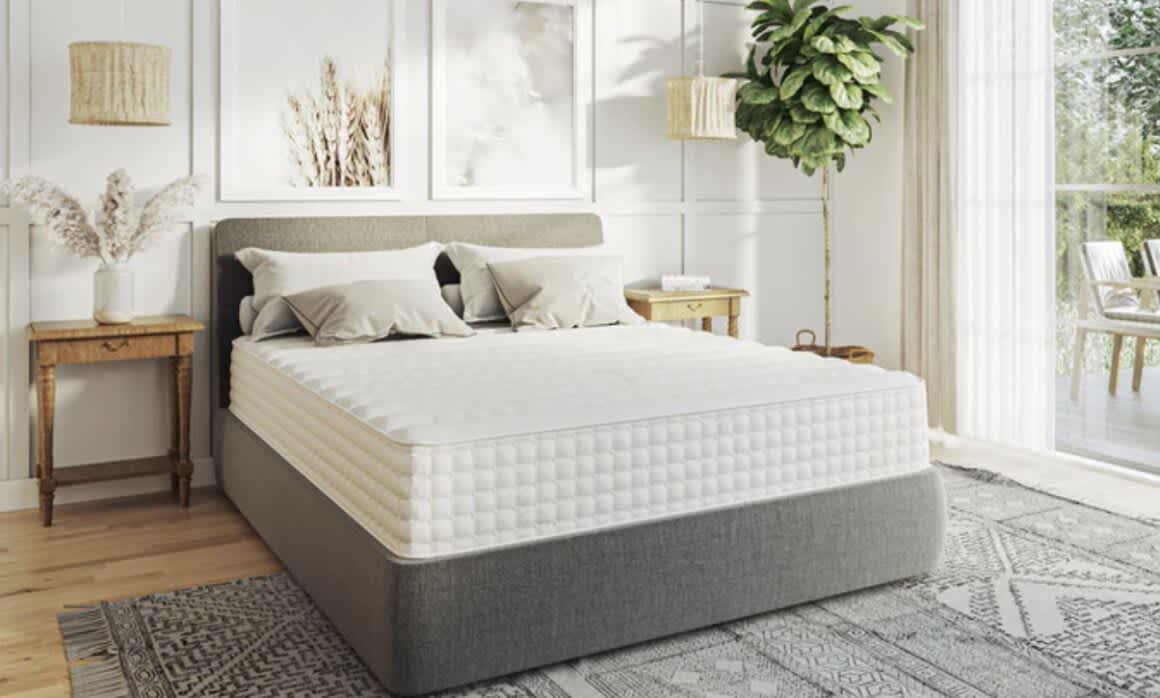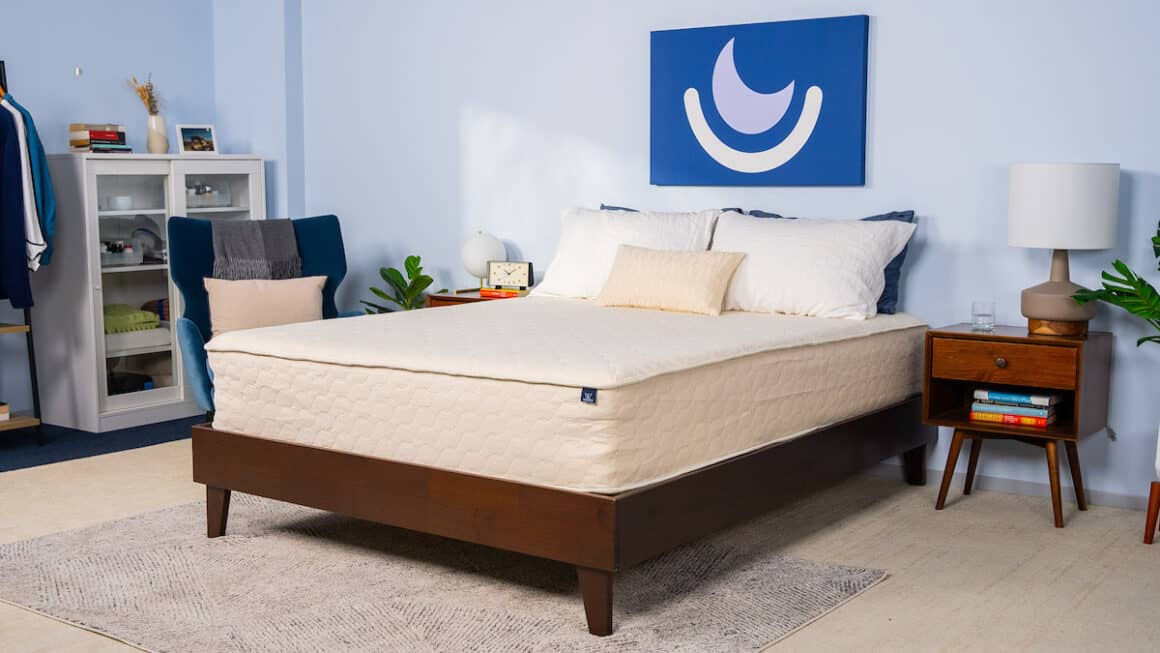On This Page
Best Latex Hybrid Mattresses of 2025
Our Top Picks
-
Best Overall Mattress
PlushBeds Luxury Bliss -
Best Value Mattress
Latex for Less Hybrid Latex Mattress -
Best Mattress for Side Sleepers
WinkBeds EcoCloud -
Best Mattress for Couples
Awara Natural Hybrid Mattress
Best Overall Mattress

Handmade in California, the PlushBeds Luxury Bliss impressed our testing team with its robust construction, organic materials, and combination of bounce and pressure relief. Offered in medium (5) and firm (7) firmness options, it delivers the dependability, temperature neutrality, and durability that we look for in a latex hybrid.
Pros & Cons
Pros
- Eco-conscious construction with certified organic latex, wool, and cotton
- Handmade with high-quality materials for long-term durability
- Available in two firmness levels
Cons
- May not appeal to sleepers who want significant hug
- Some detectable motion transfer, especially on the Firm (7) model
Ratings
Our Take
Best Value Mattress

Built with multiple layers of organic materials, the Latex for Less Hybrid is a competitively priced mattress with strong overall performance in our testing. Its durability, ease of movement, and temperature neutrality are key strengths. Available in two firmness levels, this latex hybrid can suit sleepers of diverse body weights and sleeping positions.
Pros & Cons
Pros
- Resists heat retention to promote cooler sleep
- Incorporates high-performance organic materials
- Choice of two different firmness levels
Cons
- Bounce and pushback may not suit sleepers who want to sink into their bed
- Mattress weight can make it harder to move or reposition
Ratings
Our Take
Best Mattress for Side Sleepers

The WinkBeds EcoCloud Mattress won over our testing team with its mix of pressure relief, responsiveness, and reliable edge support. The comfort layer of Talalay latex is designed to give extra cushioning to key pressure points, including the shoulders, low back, and hips, while maintaining enough pushback to prevent sinking into the mattress.
Pros & Cons
Pros
- Zoned Talalay latex comfort system can accommodate pressure points like the shoulders and hips
- Reinforced perimeter designed to boost edge support
- Sturdy design enhances stability and durability
Cons
- Only offered in one firmness level
- May lack pushback for some sleepers over 230 pounds
Ratings
Our Take
Best Mattress for Couples

The Awara Natural Hybrid Mattress demonstrated numerous strengths in our testing. In addition to being supportive and responsive, this mattress stayed cool, showed strong edge support, and offered better motion isolation than most hybrids. With a year-long sleep trial and lifetime warranty, it’s a great option for a latex hybrid.
Pros & Cons
Pros
- Extra firmness and pushback suits many sleepers over 230 pounds
- Impressive temperature neutrality and motion isolation
- 365-night sleep trial and lifetime warranty
Cons
- May be too firm for some side sleepers and people under 130 pounds
- Lacks deep contouring and hug that some sleepers seek
Ratings
Our Take
Compare Our Top Picks
| Mattress | Mattress Type | Ideal For | Value | Sleep Trial |
| PlushBeds Luxury Bliss | Latex Hybrid | Sustainable Shoppers | Great Value | 100 nights (30-night requirement) |
| Latex for Less Hybrid Latex Mattress | Hybrid | Couples | Great Value | 120 nights |
| WinkBeds EcoCloud | Hybrid | Hot Sleepers | Good Value | 120 nights (30-night requirement) |
| Awara Natural Hybrid Mattress | Hybrid | Back Sleepers | Good Value | 365 nights (30-night requirement) |
What Is a Latex Hybrid Mattress?
A latex hybrid mattress features a support core of innerspring coils and a comfort system with at least one layer of latex. Having latex in the comfort system distinguishes a latex hybrid from other hybrids, such as memory foam hybrids.
Latex is a durable material with moderate pressure relief and more bounce and pushback than most foams. It resists heat buildup better than memory foam. As a result, a latex hybrid provides better ease of movement and temperature neutrality than most other hybrids.
Types of Latex Used in Hybrid Beds
Different kinds of latex can be used in a latex hybrid. Most mattresses use natural latex, which is categorized as either Dunlop or Talalay latex based on the manufacturing process.
Dunlop Latex
Dunlop latex is molded and then baked, and this process makes it denser than Talalay latex. Dunlop latex is bouncy but typically has a firmer feel. Its simpler manufacturing process often makes Dunlop latex slightly less expensive.
Talalay Latex
Talalay latex is molded and then vacuum-sealed and flash-frozen before being baked. This makes Talalay latex more homogenous with a softer feel than Dunlop latex. While it retains plenty of bounce, Talalay latex usually has more cushioning to conform to pressure points.
Should You Buy a Latex Hybrid Mattress?
You should buy a latex hybrid if you want a mattress with a sturdy feel, moderate pressure relief, and substantial bounce. You’ll probably like a latex hybrid if you want to avoid sagging too deeply into your mattress.
A latex hybrid can also be a great fit if you’re a hot sleeper or if you’re a combination sleeper who switches between sleeping positions at night.
You may want to avoid a latex hybrid if you prefer a plush mattress that you can easily sink into.
Advantages
- Bounce and responsiveness facilitates ease of movement on the mattress
- Materials resist heat buildup
- Sturdy, durable construction
- Light contouring for pressure relief without excess sink
- Often made with eco-friendly components
Drawbacks
- Does not offer deep contouring or hug
- Bounciness can cause motion transfer across the mattress
- Typically not offered in plush firmness levels
- Heavier than most mattress types
How to Choose a Latex Hybrid Mattress
You should choose a hybrid latex mattress based on key characteristics that affect its performance while also taking into account your sleeping position, body weight, and personal preferences.
Sleeping Position and Body Weight
Your sleeping position and body weight impact your comfort and support needs. If you are a side sleeper, you may need more cushioning around your hips and shoulders. If you are a back or stomach sleeper, a mattress with more pushback may give better support to your midsection.
Your body weight can affect how much you sink into a mattress. If you weigh under 130 pounds, a softer mattress with more contouring may be optimal. If you weigh over 230 pounds, you may need a mattress with more firmness to avoid excess sinkage.
Because of their construction, latex hybrids can accommodate almost any sleeper, but you should look closely at the firmness level and the thickness of the comfort system to gauge how well it matches your needs.
Mattress Firmness
Mattress firmness describes how hard or soft a mattress feels, and it is one of the biggest factors affecting your comfort. What feels best is subjective since everyone has their own firmness preferences.
That said, a firmer latex hybrid is generally better for stomach and back sleepers and people over 230 pounds. A softer or medium firm model tends to deliver better results for side sleepers and people under 130 pounds.
Contouring and Pressure Relief
A contouring mattress will have more hug, which can relieve impact at sharp pressure points. However, too much contouring can lead to excess sinkage that pulls the spine out of alignment. Close conforming can also lead to overheating.
Latex hybrids usually offer only light or mild contouring because latex does not hug the body as much as memory foam. For most sleepers, latex hybrids provide enough pressure relief, but they may not be ideal for people who want deep contouring.
Temperature Regulation
Temperature regulation describes how well a mattress avoids heat buildup that can cause you to sleep hot. Latex hybrids usually have excellent temperature regulation. Latex does not retain as much heat as memory foam, and the coils also enable ventilation so heat can escape. As a result, latex hybrids are a popular choice among people who tend to sleep hot.
Allergies
You spend hours every night in bed, so you should account for any allergies when choosing a mattress. If you know that you have a latex allergy, it’s best to avoid latex hybrid mattresses.
Pricing
Like most hybrid mattresses, latex hybrids generally range from around $1,600 to $2,200. Latex hybrids can be more expensive than other mattress types, but pricing always depends on the details, such as the thickness and composition of each layer. Pricing also varies based on available discounts and deals.
Sleep Trial and Warranty
A sleep trial is an extended try-out period during which you can return your mattress for a refund if it isn’t working well for you. Most sleep trials for latex hybrids are around 100 nights, but some last for as long as a year.
A warranty protects against uncommon defects in materials or workmanship. Most latex hybrids have a warranty of at least 10 years. It’s important to remember that a warranty does not cover normal wear and tear.
Discover More Mattress Solutions
Now that you’ve learned all about latex hybrids, check out our other guides to learn about other options.
More Mattress Options
How We Test
All of our recommendations are based on our intensive approach to mattress testing. Our team, which has years of experience testing sleep products, thoroughly researched and evaluated a huge list of latex hybrid mattress options.
During this testing, we conduct quantitative performance analysis while also having a diverse group of sleepers see how the mattress feels. That group involves people with different body types and preferences, allowing us to obtain the most well-rounded test results to inform our recommendations.
Frequently Asked Questions
The best latex hybrid mattress delivers stability along with a combination of bounce and light pressure relief. Both latex and pocketed coils can support spinal alignment by reducing or preventing pressure points.
At the same time, these materials are responsive, keeping you from sinking in and feeling stuck in place. A high-performing latex hybrid also provides excellent temperature neutrality, edge support, and durability.
Sleeping on a latex hybrid feels like you’re getting an ideal mix of cushioning, bounce, and sturdiness. The latex layer lightly cradles pressure points while maintaining a degree of pushback and bounce that allows you to move easily on the mattress.
Unlike a memory foam mattress, a latex hybrid rarely offers deep contouring or plushness. Instead, it has a springier feel with better temperature control and edge support.
The best type of mattress depends on your preferences and sleep needs. A latex hybrid mattress is likely to be better than a memory foam mattress if you want to avoid sinking too deeply into your mattress. A latex hybrid is also usually better than a foam mattress if you tend to sleep hot or if you prioritize a mattress that is good for sex.
In many cases, a latex hybrid mattress can be excellent for back pain. The light contouring can promote spinal alignment and prevent excess sinkage, which can be especially important for back sleepers, stomach sleepers, and people over 230 pounds. Pocketed coils work in tandem with latex to offer extra support to potential problem areas like the lumbar spine.
On average, a quality latex hybrid mattress should last for around six to eight years. Because of the robust construction found in many latex hybrids, it’s possible for them to last even longer. The lifespan of any mattress varies based on how often it is used and how well it is protected from damage.
